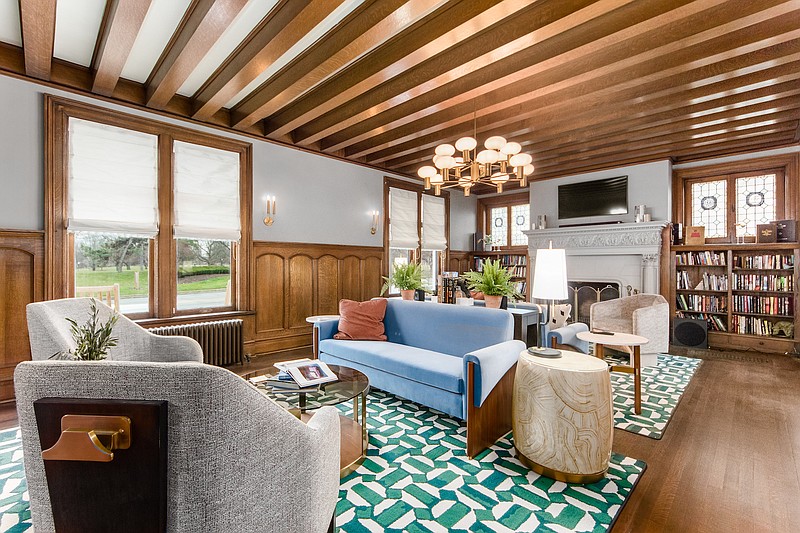I don't know about you, but as far as aging goes, I have a plan. Plan A is I will not age. Plan B is, if I must age, I will go down swinging.
Thus, I was encouraged to learn that new technology and a forward-minded designer promise to make aging at home a lot easier. And, according to a recent AARP survey, 77% of those over age 50 want to "age in place." (That is lingo for not go to a nursing home.) That percentage jumps to 86% among those over 65, which tells me that the older you get, the less appealing the idea of sitting in a nursing home under someone's thumb with no car keys becomes.
"Baby boomers are especially reluctant to give up their freedom," said interior designer Lisa Cini, a senior living design expert and owner of Mosaic Design Studio, of Columbus, Ohio. "Especially after covid went down, and assisted living centers became places no one could visit or leave, boomers are even more determined to guard their autonomy."
And she's making it easier for them. After 25 years of designing assisted living facilities, and after remodeling her own Columbus home, so it could accommodate four generations — she and her husband, their two teenagers, her 70-something parents, and her 92-year-old grandmother who had dementia — Cini channeled her personal and professional knowledge of senior living into a novel project.
After her grandmother passed away, and the kids had gone off to college and careers, she found a historic mansion in her town for sale. She bought it and turned it into a nine-bedroom Airbnb designed to host senior citizens in comfort, safety and style. (I like the style part. If I'm going to age in place, that place has to look good.)
"What more can you do besides get rid of trip hazards, add lighting, widen doorways for wheelchairs and walkers, and install lever door handles," I asked Cini over the phone.
A lot. The Werner House features more than 50 senior-centric technologies, most of which blend invisibly into the beautiful decor. "Some guests stay, and never know there's anything unusual," she added.
Indeed, as Cini takes me on a virtual tour, what strikes me most is that nothing in the 10,000-plus square-foot property screams "this is for old people!" Tech touches throughout are discreet and practical.
Marketed as an Airbnb with a mission, The Werner House (Infinite-living.org), which opened to guests in April, aims to market products subtly to those who want to age in place, and encourages them to experience new technology during their stay that they may later embrace at home, said Cini, adding that she ultimately wants to take the Airbnb concept nationwide.
Here's a sampling of the built-in amenities:
◼️ Floors that feel. Five of the suites feature Sole with SensFloor technology from Shaw Floors. The subfloor, which allows any kind of flooring to go over it, has built-in sensors that can detect when someone falls, versus when they're just sitting on the floor, and can then send the appropriate alert for help. You can also program the floor so that when your feet hit the floor from bed, the bathroom light goes on.
◼️ Noise-canceling carpet. In public areas like the dining room, speakeasy and living room, the carpet has noise cancellation technology. "Many senior citizens have hearing loss, and stop going out to eat because it's so hard for them to hear," Cini said. "The carpet absorbs the din, making conversations easier."
◼️ Firmer seats. The cushions on chairs and sofas throughout the Werner House are made of ultra-dense foam, and no seat is lower than 19 inches. Some upholstered club chairs have a handsome wood and brass hangar on their backs, for holding a folded-up walker.
◼️ Full-service bathrooms. Adjustable toilets raise up to help guests get seated, and lower for ease of use. Toilet paper holders have built-in grab bars, and bidet seats have been added to standard toilets to aid hygiene.
◼️ Sinks that sync. Bathrooms also feature adjustable sinks that can drop down to wheelchair height, sinks with side grab bars to help people stand and sit, and accessible spa tubs.
◼️ Cabinets that come to you. In kitchens, smart cabinets have a mechanism that lets them come off the wall and down to your level, a boon for those who have difficulty reaching and lifting items from upper cabinets. Once you have what you need, back goes the cabinet. Kitchen counters are height adjustable to accommodate a 5-foot woman and her 6-foot husband. "This is a big deal for cutting," said Cini, "which is all about leverage."
"Having a house that adjusts to you and keeps you safe shouldn't be out of the question," she said.
And now it's not.
Marni Jameson is the author of six home and lifestyle books, including "What to Do With Everything You Own to Leave the Legacy You Want."
